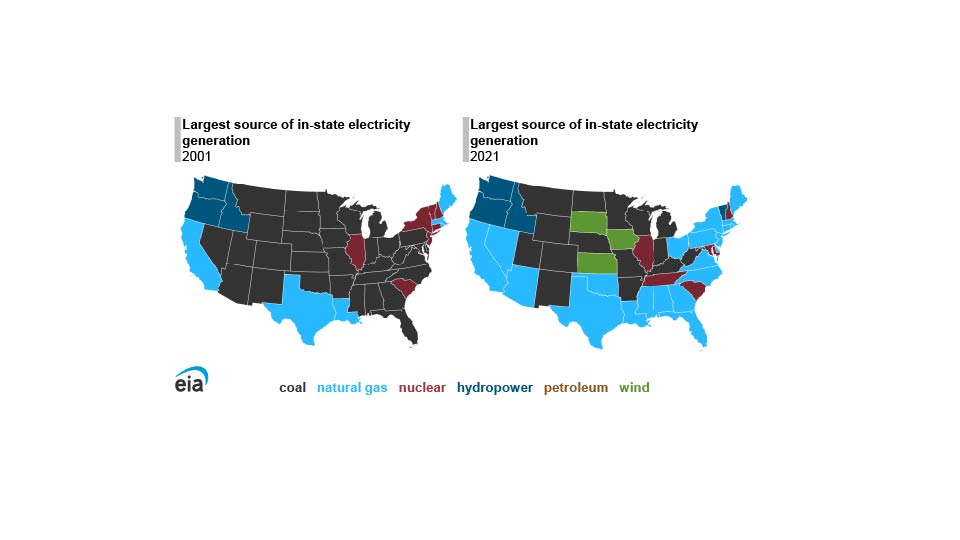
In 15 U.S. states last year, coal was used to generate electricity more than any other energy source. Twenty years earlier, in 2001, coal was the largest source of electricity generation in 32 states. The United States has shifted away from coal-fired generation since it peaked in 2007 and toward natural gas and renewables.
In 2001, natural gas was the largest source of in-state electricity generation in seven states. By 2021, that number had grown to 23 states, driven by widespread retirement of coal-fired power plants and new construction of natural gas-fired power plants. Wind and solar capacity were also growing during that time. Coal-fired plants have not been competitive economically with relatively lower-cost natural gas and renewables.
Many of the country’s coal plants were built in the 1970s and 1980s. As coal plants aged and faced price pressure from natural gas and renewables and from emissions regulations, many have been closed. Ohio and Pennsylvania had the largest declines in coal-fired capacity over the past 20 years; the largest source of electricity in both states shifted from coal to natural gas over that period.
As coal plants retired, significant natural gas-fired and renewable capacity, including wind and solar, was added. Technological advancements—namely horizontal drilling and hydraulic fracking—led to a rise in U.S. natural gas production. Low natural gas prices helped make natural gas-fired power plants an attractive alternative to coal. Texas, Florida, California, Pennsylvania, and Ohio added the most natural gas-fired capacity between 2001 and 2021. In 2021, natural gas accounted for the largest share of in-state generation in all five states.
In three states—Iowa, Kansas, and South Dakota—where coal-fired plants generated the most electricity in 2001, the largest shares of electricity generation shifted to wind turbines by 2021. All three states are located in the blustery Great Plains, where the country’s most abundant onshore wind resources are located.
Although many states have shifted away from coal as the largest source of electricity over the past 20 years, in 2021, coal still accounted for more than 70% of in-state generation in four states: West Virginia (91%), Missouri (75%), Wyoming (74%), and Kentucky (71%). Three of these states (West Virginia, Wyoming, and Kentucky) are among the nation’s largest coal producers.
A state’s total electricity supply is made up of both electricity generated in the state as well as electricity imported from other states as well as Canada and Mexico. For example, in 2021, California imported about 30% of its total electricity supply, according to the California Energy Commission. The fuel shares discussed in this article are only for in-state electricity generation.

Follow us on social media: